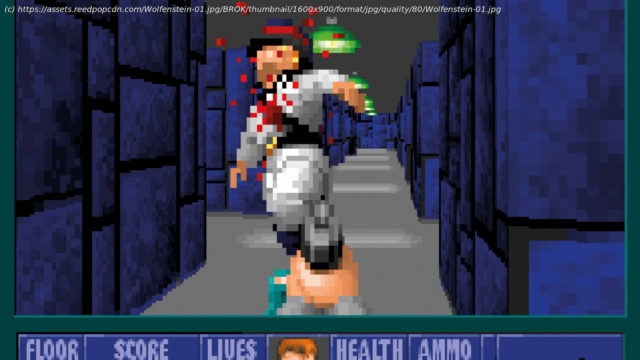Bitmap Books‘ recently released I’m Too Young To Die is a slick, beautifully produced rundown of some of the most semin…
Bitmap Books‘ recently released I’m Too Young To Die is a slick, beautifully produced rundown of some of the most seminal years for first-person shooters, chronicling the genre from 1992 to 2002 with insight from key creatives. In this excerpt, author Stuart Maine unpicks some of the key games in an incredible year for the form.
Even if id Software didn’t invent the FPS, Wolfenstein 3D was certainly the moment the genre crossed into the mainstream. Tight gameplay, a compelling theme and the shock of such realistic graphics were critical, of course, but something else that helped Wolfenstein to reach so many players was that it was distributed as shareware.
As hobby products, early videogames had no formal distribution network and were sold through computer stores or software clubs, usually as a disk or tape with photocopied instructions. As a result, there was a certain amount of luck involved in choosing a game; word-of-mouth recommendations were essential. Over time this evolved into more polished boxed products and magazine reviews, but people still had to pay up front for their games and hope they liked them.
‚Shareware‘, a term popularised by Jay Lucas in the magazine InfoWorld, allowed people to pay for software they already had. Apogee’s Scott Miller turned this into ‚the Apogee model‘: providing a portion of each game for free so players could decide if they liked it and then pay for the rest (hence Wolfenstein, DOOM and the like being divided into episodes, with the first episode given away). The rise of the internet
Initially distributed by floppy disk, full games arrived only after players had posted payment and waited. Shareware moved online as the internet grew, first through bulletin board systems, then FTP and the World Wide Web. Now people could download shareware directly from the developer or publisher and pay for immediate access.
Of course shareware had its downsides, such as the risk of downloading a virus, and the fact that anyone could release anything, making finding good games a challenge (a problem which still affects the games industry today). But the approach was a resounding success for id, with David Kushner’s book, Masters of DOOM, reporting their first month’s royalties as $100,000 (more than triple what their biggest previous game had managed). Huge numbers of people were playing, discussing and sharing Wolfenstein, and as the buzz grew, it attracted more and more interest.
It made sense, then, for id to continue to use shareware to distribute DOOM, its sequel, and Quake, though each of their games would also see release as a boxed product through a traditional publisher.
It’s worth briefly discussing game publishers here, because the vast majority of games covered in this book saw release through one. Simplifying hugely, each game has a developer – the team that creates the game – but those games are marketed and distributed through a publisher. More importantly, the publisher usually pays for the game’s development and then hopes to recoup that money through sales, meaning they have enormous power over the developer. For example, when they sign with a publisher the developer may have to hand over the rights to the IP (Intellectual Property) they’re creating, meaning the publisher now owns it. This is why you’ll see some game series abruptly change developer, with the publisher assigning subsequent games to whomever they like.
Developer: Digital Image Design
Original platforms: Amiga/Atari ST/PC
While most games based on the RoboCop licence were 2D platformers, Digital Image Design used a heavily modified version of their F29 Retaliator flight-simulator engine to create an entirely polygonal first-person adventure. There’s free-roaming driving, and a flying section, but by far the best parts are the FPS levels. None of its gameplay styles are developed enough to form a full game, but they make up for this with variety.
As RoboCop, you search back alleys, police stations, hotels and the OCP building, with a ‘hotter/colder’ beeper that certainly raises the heart rate.






